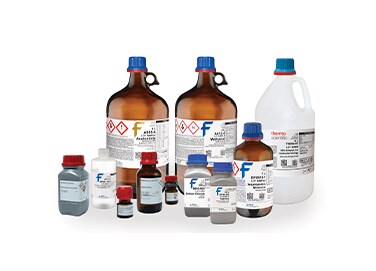

Technical-grade (Trimethylsilyl)diazomethane (approx. 2.0M in hexanes) in AcroSeal® packaging, ideal for methylations and diazo transfers.
₹68,718.00 Original price was: ₹68,718.00.₹48,103.00Current price is: ₹48,103.00.
Product Name – (Trimethylsilyl)diazomethane, technical, approx. 2.0M solution in hexanes, AcroSeal®
Quantity/Pack Size – 100ML
Form – Solution
Grade – Technical
Application – Methylating agent, diazo transfer reactions
(Trimethylsilyl)diazomethane (TMS-diazomethane) is a versatile methylating reagent supplied as a 2.0M solution in hexanes for enhanced stability and ease of handling. This technical-grade solution is packaged in AcroSeal® bottles, ensuring airtight protection against moisture and oxygen, which is critical for maintaining reagent integrity. The solution is widely recognized for its efficiency in diazo transfer reactions, enabling the introduction of diazo functionality under mild conditions. The hexane solvent system provides compatibility with a broad range of organic solvents, making it suitable for diverse synthetic applications. As a silyl-protected diazomethane derivative, it offers improved safety compared to free diazomethane while retaining high reactivity. The AcroSeal® packaging further minimizes exposure risks during storage and dispensing. This reagent is particularly valued for its ability to generate diazo compounds in situ, avoiding the need for hazardous gas handling. The technical grade ensures cost-effectiveness without compromising performance in most laboratory applications.
The solution remains stable for 12-18 months when stored unopened at 2-8°C in its original AcroSeal® packaging. Always check for discoloration or precipitate formation before use, as these indicate decomposition.
While it serves similar purposes, (Trimethylsilyl)diazomethane requires in situ activation (typically with methanol or fluoride sources) to generate the active diazo species. Reaction conditions may need optimization compared to gaseous diazomethane.
Always work in a well-ventilated fume hood due to potential diazomethane generation. Use compatible gloves (nitrile recommended) and avoid glassware with ground joints, as diazo compounds can form explosive azides with metal contaminants.
Neutralize with dilute acetic acid (1:10 v/v) in a fume hood until gas evolution ceases, then dispose according to local regulations for halogenated organic waste. Never discard untreated solution.
For less sensitive applications, consider trimethylsilyldiazomethane (2.0M in ether) or diazald® kits. For non-diazo approaches, methyl iodide or dimethyl sulfate may be suitable, though with different reactivity profiles.
Ammonium Hydrogen Carbonate, lab-grade, ideal for various laboratory applications.
Aluminon Solution, lab grade, ideal for various analytical applications.
High purity Aluminium Potassium Sulphate for lab experiments. Ideal for educational and research applications.
Hydrochloric Acid 37%, high-purity acid for laboratory applications.
High-purity Aluminium Sulphite, ideal for lab applications. Grade: Analytical. Properties: Soluble in water, stable compound.

₹68,718.00 Original price was: ₹68,718.00.₹48,103.00Current price is: ₹48,103.00.
Technical-grade (Trimethylsilyl)diazomethane (approx. 2.0M in hexanes) in AcroSeal® packaging, ideal for methylations and diazo transfers.
Product Name – (Trimethylsilyl)diazomethane, technical, approx. 2.0M solution in hexanes, AcroSeal®
Quantity/Pack Size – 100ML
Form – Solution
Grade – Technical
Application – Methylating agent, diazo transfer reactions
(Trimethylsilyl)diazomethane (TMS-diazomethane) is a versatile methylating reagent supplied as a 2.0M solution in hexanes for enhanced stability and ease of handling. This technical-grade solution is packaged in AcroSeal® bottles, ensuring airtight protection against moisture and oxygen, which is critical for maintaining reagent integrity. The solution is widely recognized for its efficiency in diazo transfer reactions, enabling the introduction of diazo functionality under mild conditions. The hexane solvent system provides compatibility with a broad range of organic solvents, making it suitable for diverse synthetic applications. As a silyl-protected diazomethane derivative, it offers improved safety compared to free diazomethane while retaining high reactivity. The AcroSeal® packaging further minimizes exposure risks during storage and dispensing. This reagent is particularly valued for its ability to generate diazo compounds in situ, avoiding the need for hazardous gas handling. The technical grade ensures cost-effectiveness without compromising performance in most laboratory applications.
The solution remains stable for 12-18 months when stored unopened at 2-8°C in its original AcroSeal® packaging. Always check for discoloration or precipitate formation before use, as these indicate decomposition.
While it serves similar purposes, (Trimethylsilyl)diazomethane requires in situ activation (typically with methanol or fluoride sources) to generate the active diazo species. Reaction conditions may need optimization compared to gaseous diazomethane.
Always work in a well-ventilated fume hood due to potential diazomethane generation. Use compatible gloves (nitrile recommended) and avoid glassware with ground joints, as diazo compounds can form explosive azides with metal contaminants.
Neutralize with dilute acetic acid (1:10 v/v) in a fume hood until gas evolution ceases, then dispose according to local regulations for halogenated organic waste. Never discard untreated solution.
For less sensitive applications, consider trimethylsilyldiazomethane (2.0M in ether) or diazald® kits. For non-diazo approaches, methyl iodide or dimethyl sulfate may be suitable, though with different reactivity profiles.
Acetic Acid Glacial A. R. is a high-purity reagent suitable for cholesterol analysis. Essential for lab research and educational purposes.
Aceto orcein 1% stain for cytology, high-grade, ideal for cytological studies.
Albumin Fixative Mayer-Lancer, high-grade for lab applications. Ideal for fixing tissues.
Alpha Naphthol, high purity, ideal for various lab applications. Suitable for students, researchers, and educators.
4-Aminoantipyrine, lab grade, essential for analytical chemistry.
Agra | Firozabad | Hathras | Mathura | Vrindavan | Aligarh | Lucknow | Ambala | Mainpuri | Shikohabad | Alwar | Bhind | Bharatpur | Morena | Gwalior | Orai | Kanpur | Jhansi | Hardoi | Shahjahanpur | Lakhimpur | Pilibhit | Haldwani | Basti | Gorakhpur | Deoria | Azamgarh | Prayagraj | Varanasi | Sultanpur | Moradabad and more….

Not a member? Create an account
Already got an account? Sign in here
By Clicking “Download Now”, you are confirming that you have read and agree to eqipped.com ‘s Terms of Use and Privacy Policy.
By Clicking “Join Now”, you are confirming that you have read and agree to eqipped.com ‘s Terms of Use and Privacy Policy.